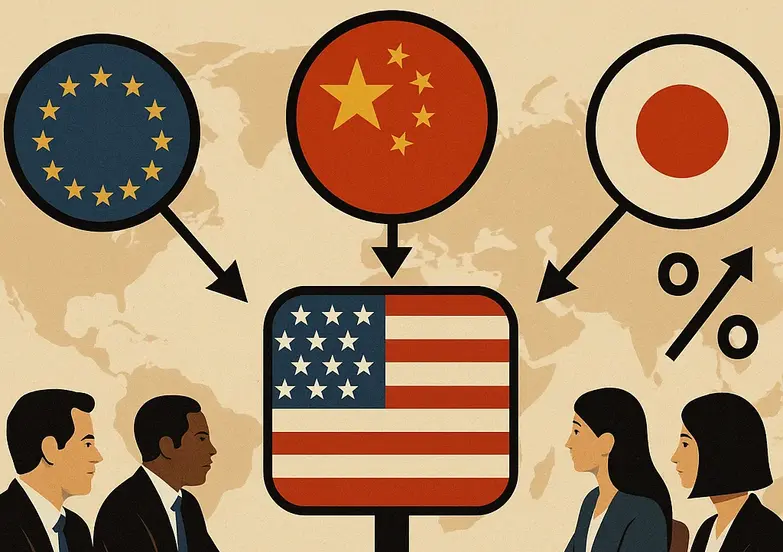As Wednesday’s critical US global tariff negotiations deadline approaches, nations worldwide are frantically working to secure trade agreements with Washington or lobby for extensions. President Trump has announced that between 12 to 15 letters regarding tariff decisions will be sent out beginning Monday, with some countries potentially receiving deals while others face the full reinstatement of reciprocal tariffs initially imposed on April 2nd. This high-stakes diplomatic and economic showdown has trading partners from Asia to Europe scrambling to protect their economic interests.
The Looming Tariff Deadline
Presidential Announcements and Timeline
President Trump recently confirmed the imminent nature of these decisions, stating, “They’ll be going out on Monday and some will go out on Tuesday and Wednesday.” The administration has signaled that the blanket tariffs on several nations will resume by July 9th unless new agreements are reached, though there are indications that engaged countries might receive a three-week extension to around August 1st if they’re participating in “serious dialogue” with the United States.
Scale and Scope of Potential Tariffs
The tariff rates facing various nations are substantial, with Asian economies bearing particularly heavy burdens. Cambodia faces potential tariffs of 49%, Thailand 36%, South Korea 25%, Japan 24%, and India 26%. These rates represent significant economic threats to export-dependent economies and have catalyzed intense diplomatic activity across multiple continents as the US global tariff negotiations deadline approaches.
Asian Nations’ Response Strategies
Northeast Asian Economic Powers
Japan and South Korea, as major automotive exporters, have expressed particular concern about the potential impact on their automobile and parts industries. Japanese Prime Minister Ishiba stated that “Japan is prepared for all possible tariff scenarios” and is “ready to stand firm and defend its interests.” Meanwhile, Japanese trade negotiator Kurzawa has engaged in multiple lengthy phone calls with US Commerce Secretary Howard Lutnick, including 45-minute and 60-minute discussions on Friday and Saturday respectively.
South Korea, facing potential 25% tariffs, has similarly engaged in high-level discussions focused primarily on steel, aluminum, and automotive sectors. Both nations represent critical US allies in a geopolitically significant region, adding diplomatic complexity to the US global tariff negotiations deadline discussions.
Southeast Asian Nations’ Approaches
Several Southeast Asian nations have made significant progress in their negotiations. Cambodia, which faces the highest potential tariff rate at 49% and relies heavily on textile and footwear exports to the US market, announced on Friday that it had “agreed to a framework agreement with the United States” with an announcement expected imminently.
Indonesia has signaled confidence that it’s close to signing what it describes as a “bold agreement” with the United States. This comprehensive deal reportedly spans critical minerals, energy, defense cooperation, and market access provisions – demonstrating how the US global tariff negotiations deadline has prompted wide-ranging economic discussions beyond simple tariff reductions.
Thailand, despite ongoing political turmoil surrounding its Prime Minister, is making what observers describe as a “last-ditch effort” to avoid the 36% tariffs it faces. The Thai government has offered greater market access for US farm and industrial goods, increased purchases of US energy products, and potentially Boeing aircraft orders as incentives to secure a favorable agreement before the deadline.
Global Diplomatic Reactions
BRICS Nations’ Coordinated Response
The BRICS nations (Brazil, Russia, India, China, and South Africa) are reportedly preparing a communiqué condemning what they characterize as the “unilateral approach to trade negotiations” taken by the Trump administration. This collective stance represents a significant diplomatic counterweight to US pressure tactics and highlights the geopolitical dimensions of what might otherwise be viewed as purely economic negotiations.
India, facing 26% potential tariffs, has indicated it might “stand firm” and implement “reciprocal measures” in response to US actions, particularly regarding automobile tariffs and sectoral tariffs on steel and aluminum. This stance demonstrates how the US global tariff negotiations deadline has prompted some nations to prepare retaliatory measures rather than acquiesce to US demands.
European Union Engagement
The European Union has also been actively engaged in negotiations with the US administration, though specific details of these discussions remain less publicized than those with Asian partners. As a major trading bloc with significant economic leverage, the EU’s approach to these negotiations could significantly influence their ultimate outcome and establish precedents for future trade relationships.
Need Career Advice in International Trade?
Wondering how the evolving US global tariff negotiations deadline might impact careers in international trade, logistics, or diplomacy? Our expert advisors can help you navigate these changing economic waters.
Get Personalized Career GuidanceEconomic Implications of Tariff Decisions
Industry-Specific Impacts
The potential tariffs would disproportionately affect certain industries, with automotive, steel, aluminum, textiles, and footwear sectors facing particularly significant disruptions. For instance, Cambodia’s 49% tariff would severely impact its textile and footwear exports, which constitute a major portion of its economy and employment base.
Similarly, the automotive industries in Japan, South Korea, and India would face substantial challenges from increased tariffs, potentially disrupting global supply chains that have been established over decades. These industry-specific impacts highlight how the US global tariff negotiations deadline represents not just a diplomatic challenge but an immediate economic threat to specific sectors and the workers they employ.
Global Supply Chain Disruptions
The interconnected nature of modern global supply chains means that tariffs imposed on one country often have ripple effects across multiple economies. Components may cross borders several times during production, potentially incurring tariffs at multiple stages. This complexity makes predicting the full economic impact of the threatened tariffs particularly challenging.
Economists have warned that substantial disruptions to established supply chains could lead to increased consumer prices, reduced product availability, and potential job losses across multiple countries. The uncertainty surrounding the US global tariff negotiations deadline has already prompted some companies to begin contingency planning for alternative supply arrangements.
Key Players in the Negotiations
US Negotiation Team
The US negotiation efforts are being led by several key figures in the Trump administration:
- Scott Benson is spearheading many of the direct negotiations with trading partners
- Howard Lutnick, the Commerce Secretary, has been actively engaged in discussions with counterparts like Japan’s Kurzawa
- The Treasury Secretary has also played a significant role in the financial aspects of these trade discussions
This high-level engagement demonstrates the priority the administration places on reshaping trade relationships and securing what it considers more favorable terms before the US global tariff negotiations deadline.
Strategic Approaches by Trading Partners
Different nations have adopted varying strategies in response to US pressure:
- Some, like Cambodia and Indonesia, have sought comprehensive agreements covering multiple sectors
- Others, like Japan, have indicated willingness to stand firm and potentially weather the economic impact of tariffs
- Thailand has offered specific concessions in areas of US interest, such as agricultural market access and aircraft purchases
- India has suggested it might respond with reciprocal measures rather than acceding to US demands
These diverse approaches reflect differences in economic leverage, domestic political considerations, and strategic priorities among US trading partners as they navigate the US global tariff negotiations deadline.
Hiring International Trade Specialists? Post Jobs for Free with WhatJobs
Looking to recruit experts who understand the complexities of the US global tariff negotiations deadline and international trade regulations? Connect with qualified candidates who can help your company navigate these challenging economic waters.
Post Your Job OpeningsPotential Outcomes and Scenarios
Extension Possibilities
According to Scott Bessen, countries actively engaged in “serious dialogue” with the United States might receive three-week extensions to the deadline, potentially pushing it to around August 1st. This would provide additional negotiation time while maintaining pressure on trading partners to reach agreements favorable to US interests.
The possibility of extensions introduces strategic considerations for nations approaching the US global tariff negotiations deadline. Some may calculate that demonstrating engagement without making significant concessions could be sufficient to secure temporary relief, while others may rush to finalize deals to eliminate uncertainty.
Long-Term Trade Relationship Impacts
Beyond the immediate question of whether tariffs will be imposed, these negotiations are reshaping long-term trade relationships and establishing precedents for future economic interactions. The aggressive approach taken by the US administration could prompt trading partners to:
- Diversify their export markets to reduce dependence on US consumers
- Form stronger regional trade alliances as counterweights to US pressure
- Develop domestic industries to reduce reliance on imports
- Establish new supply chains that minimize exposure to US tariff policies
These structural changes could have lasting implications for global trade patterns long after the current US global tariff negotiations deadline has passed.
FAQ: US Global Tariff Negotiations Deadline
What specific tariff rates are countries facing if no deal is reached by the US global tariff negotiations deadline?
The potential tariff rates vary significantly by country, with some Asian economies facing particularly high rates. Cambodia could see tariffs of 49%, Thailand 36%, South Korea 25%, Japan 24%, and India 26%. These rates represent substantial increases that would significantly impact export competitiveness for these nations. The US global tariff negotiations deadline of July 9th marks when these rates would take effect unless agreements are reached or extensions granted, making the current negotiations critically important for affected economies.
How are different Asian countries responding to the US global tariff negotiations deadline?
Asian nations have adopted diverse strategies in response to the US global tariff negotiations deadline. Japan has stated it’s “prepared for all possible tariff scenarios” while engaging in intensive negotiations. Cambodia has reportedly agreed to a framework agreement with the United States. Indonesia signals confidence about signing a “bold agreement” covering critical minerals, energy, defense cooperation, and market access. Thailand is making last-ditch efforts by offering greater market access for US goods and potential Boeing aircraft purchases. Each country’s approach reflects its specific economic vulnerabilities and leverage in these high-stakes negotiations.
What industries would be most affected by tariffs if agreements aren’t reached by the US global tariff negotiations deadline?
The industries most vulnerable to tariffs after the US global tariff negotiations deadline include automotive manufacturing (particularly affecting Japan, South Korea, and India), steel and aluminum production, textiles and footwear (especially impacting Cambodia and other Southeast Asian nations), and electronics. These sectors often represent significant portions of national exports and employment in affected countries. The potential disruption extends beyond direct tariff costs to include supply chain complications, market access challenges, and potential job losses across multiple interconnected industries if agreements aren’t reached.
Could countries receive extensions to the US global tariff negotiations deadline?
Yes, according to US negotiator Scott Bessen, countries actively engaged in “serious dialogue” with the United States might receive three-week extensions to the US global tariff negotiations deadline, potentially pushing it to around August 1st. This would provide additional negotiation time while maintaining pressure on trading partners. Approximately 18 of the top US trading partners that haven’t already reached deals are reportedly in active negotiations. The letters President Trump mentioned sending out beginning Monday may include notification of these extensions for certain countries, giving them additional time to finalize agreements.
What are the BRICS nations saying about the US global tariff negotiations deadline approach?
The BRICS nations (Brazil, Russia, India, China, and South Africa) are reportedly preparing a communiqué condemning what they characterize as the “unilateral approach to trade negotiations” taken by the Trump administration ahead of the US global tariff negotiations deadline. India specifically has indicated it might “stand firm” and implement “reciprocal measures” in response to US actions, particularly regarding automobile tariffs and sectoral tariffs on steel and aluminum. This collective stance represents a significant diplomatic counterweight to US pressure tactics and highlights how the US global tariff negotiations deadline has prompted some nations to coordinate their responses rather than negotiate individually.
For more insights on global economic trends, read our analysis on Global Economic Outlook 2024 and Global Debt Crisis 2024.




